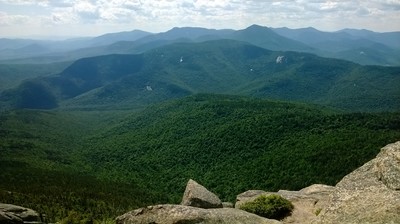|
A literal reading of Genesis would imply the stars to be well under seven thousand years old, but then how is it we can see light from galaxies so far away that the light should have taken billions of years to get here? Several explanations have been presented.
Could the stars not be as far as we think? Distance is measured in different ways. The closest stars can be measured by parallax. When Earth is on one side of the sun, we see the star at one angle relative to the background stars. When the Earth is on the opposite side of the sun six months later, we see the star at a slightly different angle. Determining the distance is then a matter of trigonometry. It is hard to see how this method could fail. Determining the distance of farther stars is done using various other methods (such as the relationship of color to brightness) that are proven accurate in those cases where the stars are close enough to use parallax also. It doesn’t seem possible for astronomers’ estimates to be off by enough for all the billions of stars we see to fit into a sphere less than seven thousand light-years across. Could God have created the light from those stars already on route to us so we could see them right away? God can do anything, but putting false images in the sky makes him a liar. Astronomers have observed stars explode that were much further than a few thousand light-years. The light should not have reached us yet from whatever is left there now, which would not be a star anymore, yet we saw it as a star for many years before we saw it explode. This means that if God put the light there in the sky, he planted images of stars that never existed. If God is omnipotent and a liar, there is no hope that anything in science is true and we might as well just give up trying to learn anything about anything. This is not a very satisfactory explanation. Could the speed of light have been higher in the past? This is very unlikely. Pulsars are stars that spin very fast, sometimes thousands of times per second. They hold themselves together by being as dense as an atomic nucleus. This means they are only a few kilometers across yet have mass in excess of our sun. At those scales, gravity is able to keep them from flying apart. If the speed of light had dropped in the past, the pulses seen from these incredible stars would arrive slower than they were sent out, meaning that pulsars actually spin faster than we see. In order for light from objects fourteen billion light-years away to have reached us, the speed of light must have dropped so much that pulsars would be spinning so fast that there is no way under known physics for them to exist. Could Genesis be meant metaphorically? Might the days of creation week be longer than twenty-four hours? Perhaps, but each “day” is divided from the others by a night cycle. Also, the Genesis account has plants being created before the sun and moon. While there was already light for the plants to possibly live, the lack of a sun to produce this light just raises more questions. The most likely interpretation is that the days are very short – literally twenty-four hours. Could Genesis simply be wrong? Might the mainstream scientists be right that the universe is well in excess of ten billion years old? This is by far the most popular explanation, and I’m willing to entertain it, but could there be another? Starlight And Time: Many years ago, Dr. Russell Humphreys published a short book titled Starlight And Time, suggesting that due to the shape of our spacetime, six thousand years on Earth might have been twenty billion years at the edge of the observable universe. We know from Einstein’s theories of special relativity and general relativity that time need not run at the same rate for all observers. Whether his model makes sense I cannot tell. His book is packed with math that he never explains. This makes my crackpotometer go off. I need someone reputable to take a look at it, but I already know from overwhelming experience that mainstream scientists are heavily biased against anything that might threaten their pet theories. They are just as bad. This continues to leave me hanging. Fortunately, I don’t need to know. It isn’t as if believing the wrong thing will send me to Hell. I don’t believe that. It’s just fun to think about the possible forms reality can take. This brings me to one other possibility I thought up myself. What if time has more than one dimension? Stephen Hawking writes of something called imaginary time, which would be at right angles to normal time (think imaginary numbers on the complex-number plane). I’m not sure if that applies here, but if there is another dimension to time it could mean that billions of years passed on Earth while God experienced creation lasting only a week sideways. His ways are not our ways. Could it be that all of history is like a novel God is writing and continually refining, going back and changing the past in order to make a better story? What do you think?
0 Comments
Leave a Reply. |
AuthorMy name is Dan. I am an author, artist, explorer, and contemplator of subjects large and small. Archives
February 2023
Categories
All
|



 RSS Feed
RSS Feed